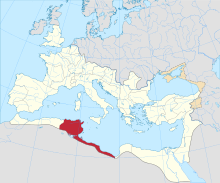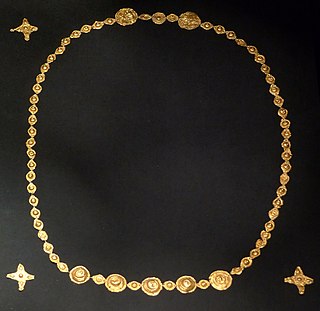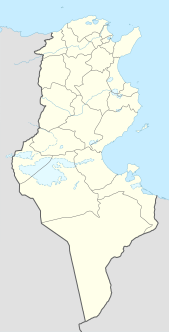
Uzzipari was a Roman town of the Roman Empire during late antiquity. An exact location for the town has been lost to history [1] although that it was in the Roman province of Africa Proconsolaris means it must have been in northern Tunisia.

In the history of Rome, the Latin term civitas, according to Cicero in the time of the late Roman Republic, was the social body of the cives, or citizens, united by law. It is the law that binds them together, giving them responsibilities (munera) on the one hand and rights of citizenship on the other. The agreement (concilium) has a life of its own, creating a res publica or "public entity", into which individuals are born or accepted, and from which they die or are ejected. The civitas is not just the collective body of all the citizens, it is the contract binding them all together, because each of them is a civis.

The Roman Empire was the post-Roman Republic period of the ancient Roman civilization. Ruled by emperors, it had large territorial holdings around the Mediterranean Sea in Europe, North Africa, the Middle East, and the Caucasus. From the constitutional reforms of Augustus to the military anarchy of the third century, the Empire was a principate ruled from the city of Rome. The Roman Empire was then divided between a Western Roman Empire, based in Milan and later Ravenna, and an Eastern Roman Empire, based in Nicomedia and later Constantinople, and it was ruled by multiple emperors.

Late antiquity is a periodization used by historians to describe the time of transition from classical antiquity to the Middle Ages in mainland Europe, the Mediterranean world, and the Near East. The popularization of this periodization in English has generally been accredited to historian Peter Brown, after the publication of his seminal work The World of Late Antiquity (1971). Precise boundaries for the period are a continuing matter of debate, but Brown proposes a period between the 3rd and 8th centuries AD. Generally, it can be thought of as from the end of the Roman Empire's Crisis of the Third Century to, in the East, the early Muslim conquests in the mid-7th century. In the West the end was earlier, with the start of the Early Middle Ages typically placed in the 6th century, or earlier on the edges of the Western Roman Empire.
In antiquity the town was also the seat of a Christian bishopric, [2] [3] suffragan of the Archdiocese of Carthage.

Ancient history as a term refers to the aggregate of past events from the beginning of writing and recorded human history and extending as far as the post-classical history. The phrase may be used either to refer to the period of time or the academic discipline.

A cathedra or bishop's throne is the seat of a bishop. It is a symbol of the bishop's teaching authority in the Catholic Church, the Orthodox Church, and the Anglican Communion churches. Cathedra is the Latin word for a chair with armrests, and it appears in early Christian literature in the phrase "cathedrae apostolorum", indicating authority derived directly from the apostles; its Roman connotations of authority reserved for the Emperor were later adopted by bishops after the 4th century. A church into which a bishop's official cathedra is installed is called a cathedral.
The episcopal see of Carthage, the city restored to importance by Julius Caesar and Augustus, in which Christianity was firmly established by the 2nd century, was the most important in the whole of Roman Africa and continued as a residential see even after it had fallen to the Muslim conquest, until the start of the second millennium.
There are three documented bishops of this diocese.
- the Catholic Bishop Mariano attended the Council of Carthage 411, and participated in another council of Carthage in 419.
- Augenzio who attended the synod in Carthage called by the Vandal king Huneric in 484, after which Augenzio was exiled.
- Semenzio took part in the Carthaginian council of 525.

Carthage was the center or capital city of the ancient Carthaginian civilization, on the eastern side of the Lake of Tunis in what is now the Tunis Governorate in Tunisia.

The Vandals were a large East Germanic tribe or group of tribes that first appear in history inhabiting present-day southern Poland. Some later moved in large numbers, including most notably the group which successively established kingdoms in the Iberian Peninsula and then North Africa in the 5th century.
Today Uzzipari survives as a titular bishopric of the Roman Catholic Church and the current Bishop is Thomas Chakiath of Ernakulam-Angamaly. [4]
A titular bishop in various churches is a bishop who is not in charge of a diocese. By definition, a bishop is an "overseer" of a community of the faithful, so when a priest is ordained a bishop, the tradition of the Roman Catholic and Orthodox churches is that he be ordained for a specific place. There are more bishops than there are functioning dioceses. Therefore, a priest appointed not to head a diocese as its diocesan bishop but to be an auxiliary bishop, a papal diplomat, or an official of the Roman Curia is appointed to a titular see.
A bishop is an ordained, consecrated, or appointed member of the Christian clergy who is generally entrusted with a position of authority and oversight.
Mar Thomas Chakiath
ܡܵܪܝ ܬܐܘܿܡܐܵ ܐܲܦܸܣܩܘܿܦܵܐ is a retired Syro Malabar Catholic Bishop. He was the Auxiliary Bishop of the Archdiocese of Ernakulam-Angamaly.




